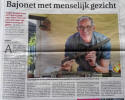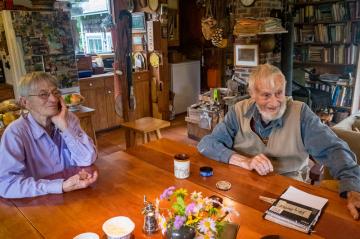|

Bayonet Now Has A Human Face
says the headline in this Dutch newspaper.
"Andre Duijghuisen
from Venray goes to New York to return a bayonet to a veteran,"
continues the sub-title.
The destination of New
York perhaps refers to where Andre was to enter the U.S. on his trip
to Massachusetts's Cape Cod and the town of Tisbury, not far from
Provincetown at the tip of the Cape.
An American newspaper
picks up the rest of the story ...
WEST TISBURY - His
bayonet was returned to American veteran Nelson Bryant after 73 years
by André Duijghuisen of Holland.
The weapon was found by André Duijghuisen in his father's house in Groesbeek. Bryant lost the bayonet during Operation Market Garden during World War II.
André heard the stories about Operation Market Garden and the fights around Groesbeek and De Horst
from his father who lived on the Cranenburgsestraat
[Groesbeek] ner the site of the air landings of September 1944.
When the parental home was vacated, in the summer of 2016, the pieces that Andre's father had collected, including a bayonet, appeared again.
Search for the
owner
The name of Bryant was
inscribed on the bayonet. After a long investigation, Duijghuisen succeeded in finding Bryant in the United States.
There followed mail contact, and Bryant promised to send André a report of his memories of September 1944.
In the mail contact, an appointment was made and on Friday the bayonet could finally be handed over.
View the report with images of the handover (text goes further under video)
"I did not remember the bayonet was so big," Bryant says at the handover." Duijghuisen did not know
how the bayonet came to be with his father, but the veteran
said, 'The handwriting is mine'.
However, he has no clear explanation of how his bayonet remained in the Netherlands. "I wanted to cut my dog, but there was so much
going on about me and then I let it down."
Bryant's wife says he still talks a lot about the war. "I think if you killed someone and experienced such a war that you were
marked for your life."
Nelson Bryant is 94 years now. He never returned to the Netherlands after the
war.

[photo by Ruth Kirchmeier]
Nelson Bryant marvels
at the trench knife returned to him by Andre Duijghuisen, at right. |

Ruth Kirchmeier and Nelson Bryant in their West Tisbury
home. — Mark Lovewell
How Nelson Bryant,
U.S. Army, 82nd Airborne Division, 508th parachute infantry
regiment, lost his standard issue U.S. Army trench knife in combat
is quite a story. How he got it back is an even better one.
On Sept. 17, 1944, Mr.
Bryant was in a pretty tight spot. He was still recovering from a
previous gunshot wound to the chest and had taken a little shrapnel
in one leg as he parachuted into occupied Holland. With German
soldiers firing from an uncomfortably close distance, he couldn’t
get out of his parachute harness. Before the jump, it took two men
to buckle the ill-fitting harness around his chest. Now he couldn’t
get the buckles apart.
So he took his trench
knife out of its sheath and began to cut the harness off. He finally
got free, and scrambled to safety.
“There were some
Germans shooting at me from about 150 yards away, and they were
getting damn close,” said Mr. Bryant, reminiscing this week in the
coziness of his West Tisbury home. “As near as I can tell, what
happened was I was pretty excited, and a little upset. I remember I
cut some of my clothes I was so nervous. I cut out of the harness.
What I think I did, I simply forgot my knife and left it there on
the ground in its sheath.”
More than seven
decades later, thanks to some incredible Internet sleuthing by a
Dutch man who admires his service in World War II, Mr. Bryant is
getting his trench knife back. The former outdoor columnist for the
New York Times knows a good story when he hears one.
The story begins at
Dartmouth College in 1943. The transition from rural and wild West
Tisbury to the Ivy League environs of Hanover, New Hampshire left
Mr. Bryant restless.
“The world is torn
apart, guys my age are dying, and I’m sitting here going to
Dartmouth,” Mr. Bryant said. “I said the hell with it, and I
volunteered for the draft.”
His first Army
assignment involved handing out clothes to members of an
intelligence division in Washington, D.C, and he soon became
restless at that, too. He volunteered for the 82nd Airborne, and in
the spring of 1944, He was in Nottingham, England for training.
He was among the first
American soldiers into occupied France, parachuting behind enemy
lines the night before Allied forces stormed the beaches at Normandy
on D-Day. Four days later, while on a reconnaissance mission, he
found himself looking death square in the eye when he was shot in
the chest.
“I heard machine gun
fire, the next thing I know, bam,” said Mr. Bryant. “It went in the
front, came out the back, 50 caliber. I thought, is this it? I could
hear distant gunfire, I could hear cows mooing in the pasture.”
Now 94, Mr. Bryant
doesn’t see, hear or remember as well as he used to, but he can
still sling cuss words around like a soldier, and the sparkle
returns to his eyes as he remembers the war stories with a
newspaperman’s detail. |
Some of his fellow
soldiers thought he was dead as he lay bleeding in the French
countryside, but with the some help, he got to a rear position,
where he laid in a hedgerow for four days, before finally getting
shipped to a field hospital in Wales.
While recuperating
there, he began taking short walks and then short runs, trying to
get back in shape. When he heard his unit was about to make another
jump, he asked the doctors if he could be released. They asked him
if he was out of his mind.
“When no one was
looking I got my clothes and put them on, walked out of the
hospital, and thumbed rides on U.S. military vehicles back to
Nottingham, England, and got there a week before we made the jump
into Holland,” said Mr. Bryant.
Earlier this year,
some 73 years after the day he parachuted into Groesbeek, Holland,
Mr. Bryant picked up the telephone. On the other end of the line was
André Duijghuisen, a 56-year-old educator from Holland. Mr.
Duijghuisen had been cleaning out his father’s attic in Groesbeek,
where the exploits of the U.S. soldiers are still legendary. In the
attic, along with other relics of the war, he found a knife.
Scratched into the sheath was the name Bryant.
“Searching on the name
of Bryant, I found he served in the 82nd Airborne division and the
508th regiment,” said Mr. Duijghuisen, speaking by phone from New
York on Wednesday. “I searched a little bit further and found some
articles he wrote for the New York Times.”
A bit more searching
and he found Mr. Bryant lived in West Tisbury, and was listed in an
Internet phone directory.
“I was startled,” said
Mr. Bryant, remembering the phone call. “He said bayonet, and I knew
something was wrong because I knew the gun I carried you couldn’t
use a bayonet. Then I realized I was talking to a civilian and he
wouldn’t know a bayonet from a trench knife. When he said there was
a leather sheath, that was a clue.”
In the months since
that first phone call, the two men have exchanged emails frequently.
The educator and the newspaperman say they’ve gotten to know each
other a bit. One thing led to another, and Mr. Duijghuisen and his
wife arranged to travel to New York, and then to Martha’s Vineyard
this weekend. The trench knife, in it’s sheath with the name Bryant
scratched into it, is tucked safely in his suitcase. He will return
it when the two men meet.
Mr. Bryant said the
return of his knife doesn’t stir up old memories. Those memories
never went away. “All of my thoughts, I think about it all the
time,” said Mr. Bryant. “My war time service is one of the big
events of my life. It obscures everything else, almost.”
He saw some terrible
things, brushing death several times, but the Allied forces
eventually prevailed, and the German forces were driven out of
Holland.
Mr. Duijghuisen wasn’t
even born when Mr. Bryant fell out of the sky that day in 1944. So
why expend so much effort to find an old soldier, and travel
thousands of miles to see him?
“The name on the
bayonet, it made, for me, something personal,” said Mr. Duijghuisen.
“Because of what he did in 1944, and because we are now living in a
free world. I think a lot about that. He fought in Holland for our
freedom. I’m very excited about that, it will be nice to see him.”
|


